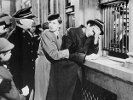Eye For Film >> Movies >> Spellbound (1945) Film Review
Spellbound
Reviewed by: Yusuf Javed

In what must have been a slow year for the Academy Awards, 1945 saw this multi-nominated feature hit screens. Made during Hitchcock’s early Hollywood years Spellbound was another of his pictures that was made under distinguished producer David O Selznick's rule, following the Oscar success of Rebecca. During this period there was constant friction between two cinematic legends due to Selznick's habit of hiring out Hitchcock - who was under contract to him - to other studios, charging them way more for the privilege than he was paying the director. The antagonism between them meant the two were in a constant tug of war over cash and control.
Spellbound was one of the few cases where Selznick did not hire out Hitchcock and instead produced the film in-house himself. The producer wanted to create a film after his own experiences with psychoanalysis and, under advisement, bought the rights to the original novel The House Of Dr Edwards for $40,000. The result of the two men working together, however, was another duel for dominance.

Gregory Peck stars (in one of his non-stache productions) as the new head of the psychoanalysis centre Green Manor. When Peck first makes his appearance he catches the eye of the affection-avoiding Dr Constance Peterson (Ingrid Bergman). In just one day they are propelled into a romantic relationship that is struck down almost as fast as it started, when she discovers Peck is not who he says he is. Bergman is torn between reporting the impostor or curing her new found lover's amnesia, which is causing his larger than life identity crisis.
The film marks the first collaboration between Bergman and the Master of Suspense and the actress creates a real sense of the character's constant dilemma and of hope unravellingy. The starring pair work brilliantly against one another, perfectly catching the shifting emotions of their evolving situation.
Mention must also be made of Salvador Dali, who created the famous dream sequencing in the movie. This is one of the film's fantastic and unique hooks, as Peck talks of the bizarre dream he has had the night before and Bergman and her professor attempt to decipher it. However, despite being one of the most attention-grabbing moments in the film, it was quickly cut down. The sequence was rumoured to have been around 20 minutes long but was edited to what we have now on the orders of Selznick.
The true climactic scene stealer comes at the end in the offices of Green Manor. Hitchcock pulls off a great shot similar to the famous Dial M For Murder ring pull, but better. The shot is held to brilliant suspenseful effect and ends in the only flash of colour in the black and white film.
All in all Spellbound makes for a good watch but shouldn’t be too highly hyped. The friction created by Selznick and Hitchcock sticks out and the viewer can feel this back-and-forth sensation of conflict in the story. The pacing towards the end crams huge amounts of plot into a small space of time. If somebody was to watch this in the lackadaisical, dream-like state that the original posters suggest then they may come out satisfied. If somebody goes in feeling they are about to watch another great in Hitch’s cinematic ranks they may feel a bit robbed. But for performance and style alone, it’s worth a watch.
Reviewed on: 13 Aug 2010


















